Abstract
The human P1-450 gene (6,311 base pairs), as well as the 5' (1,604 bases) and 3' (113 bases) flanking regions, have been completely sequenced. Four highly homologous boxes (61, 82, 56 and 97 base pairs) between the human and mouse P1-450 genes are found in the "TATA" box promoter region, -226, -338, and -450 upstream from the cap site, respectively. Nine genomic-DNA samples were digested with each of 23 restriction endonucleases and probed with human P1-450 cDNA fragments; restriction fragment length polymorphisms are detected, although it remains to be seen whether such a recombinant DNA test will be useful in determining individuals at increased risk for cigarette smoking-induced cancer and toxicity. We show in this report, however, that human inducible P1-450 mRNA concentrations are very highly correlated (r = 0.98; N = 6) with genetic differences in benzo[a]pyrene metabolism in mitogen-activated lymphocyte cultures.
Full text
PDF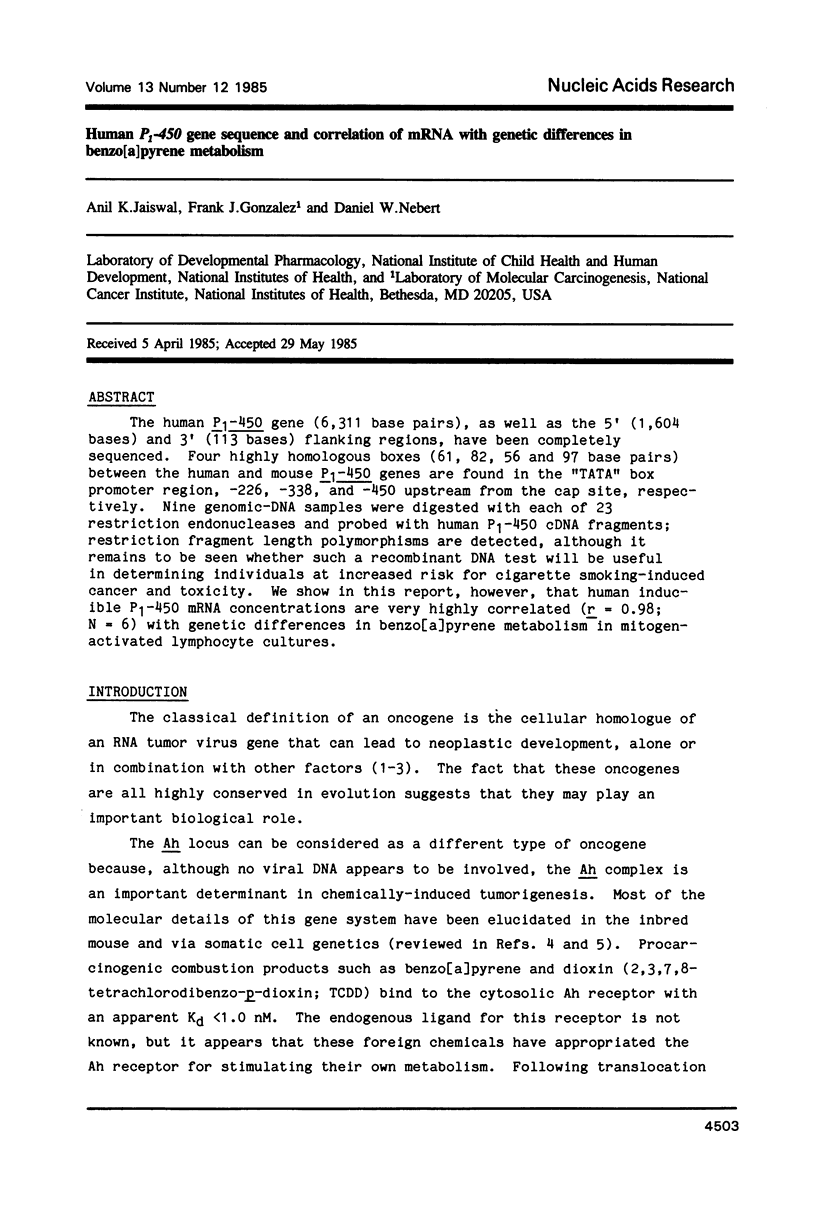
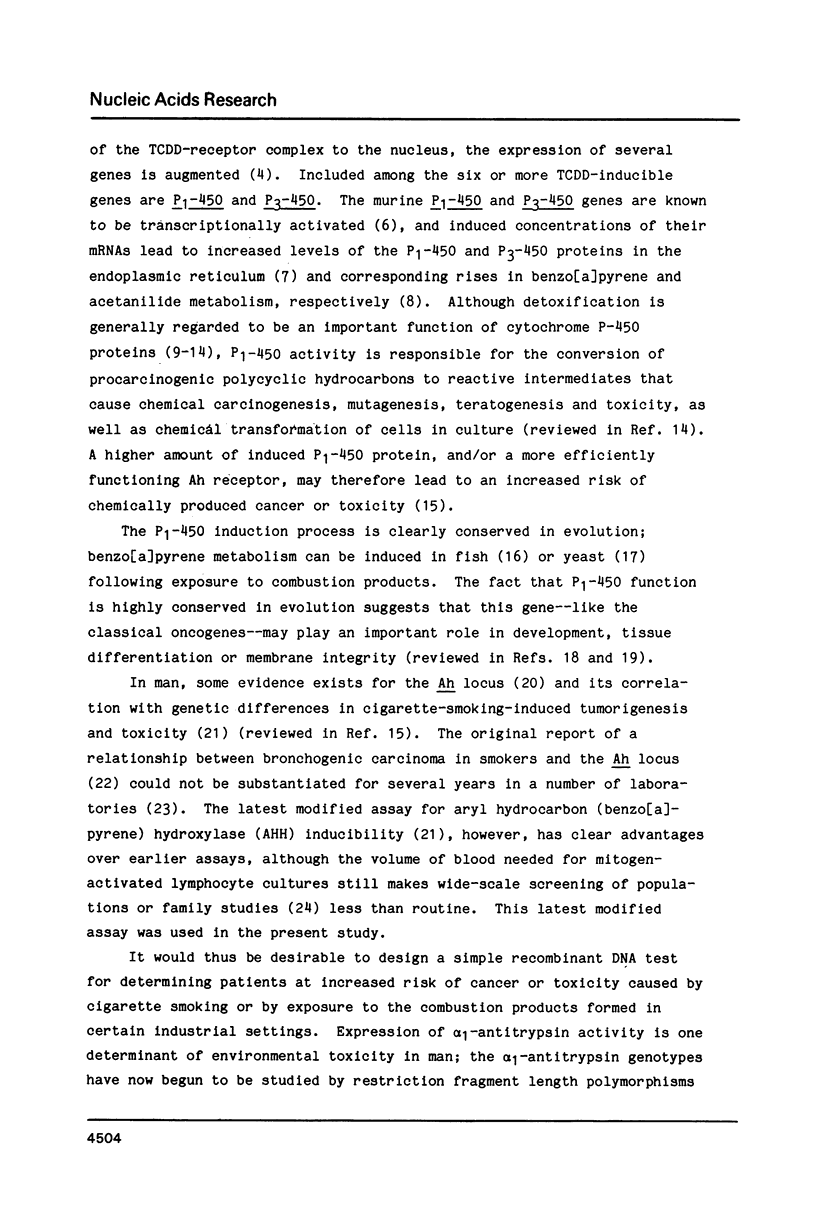
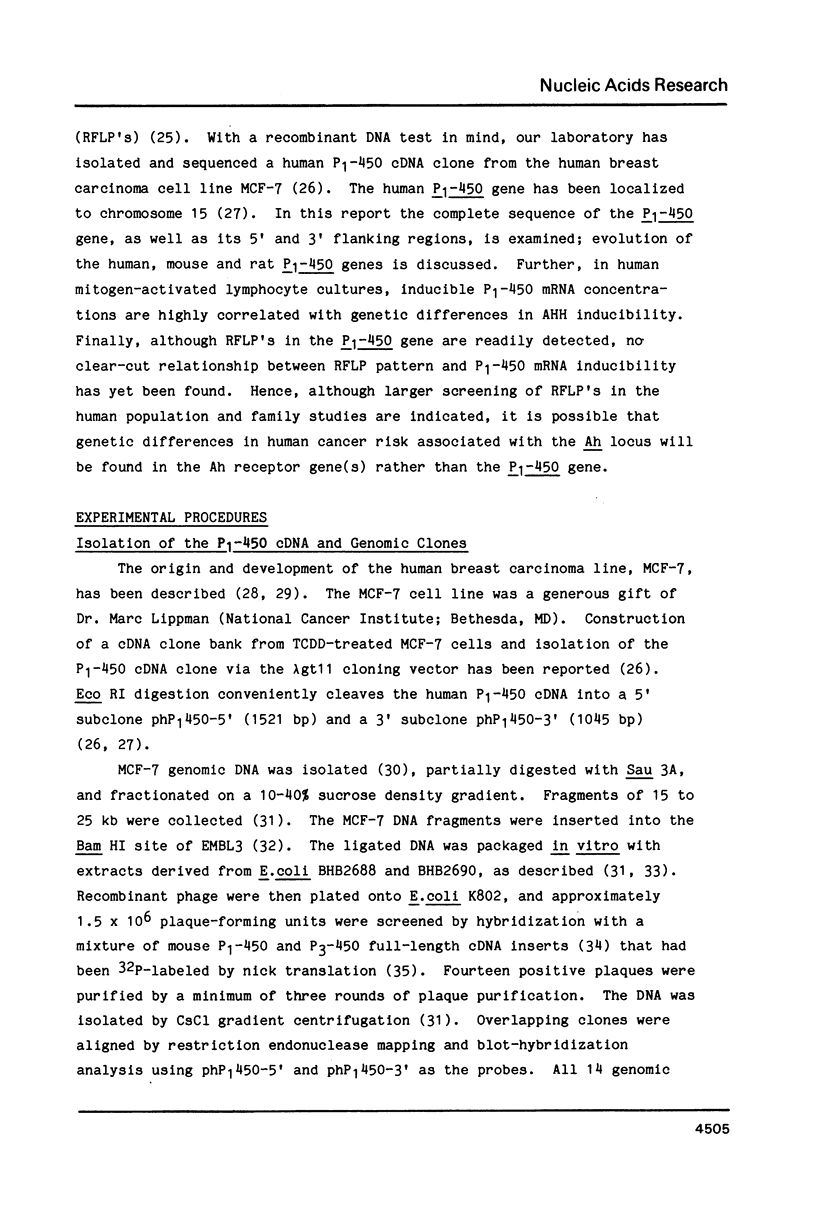
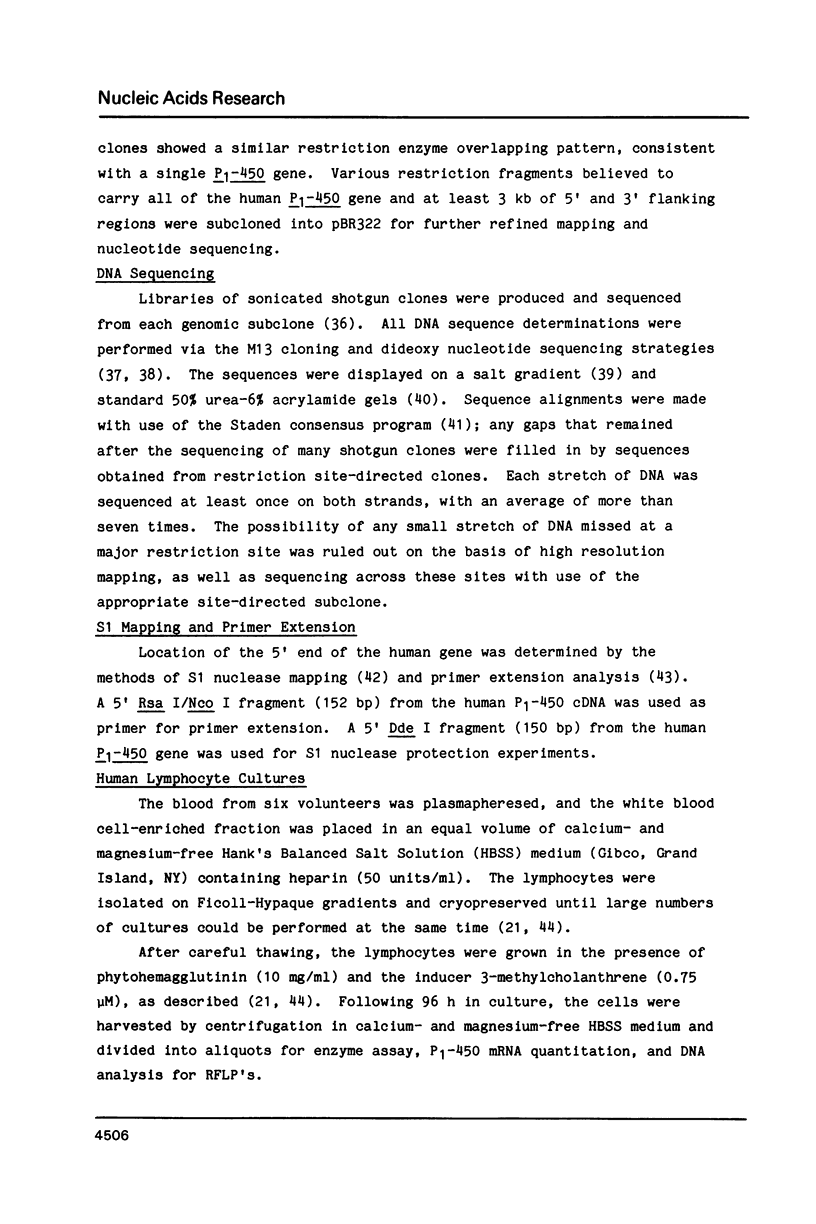
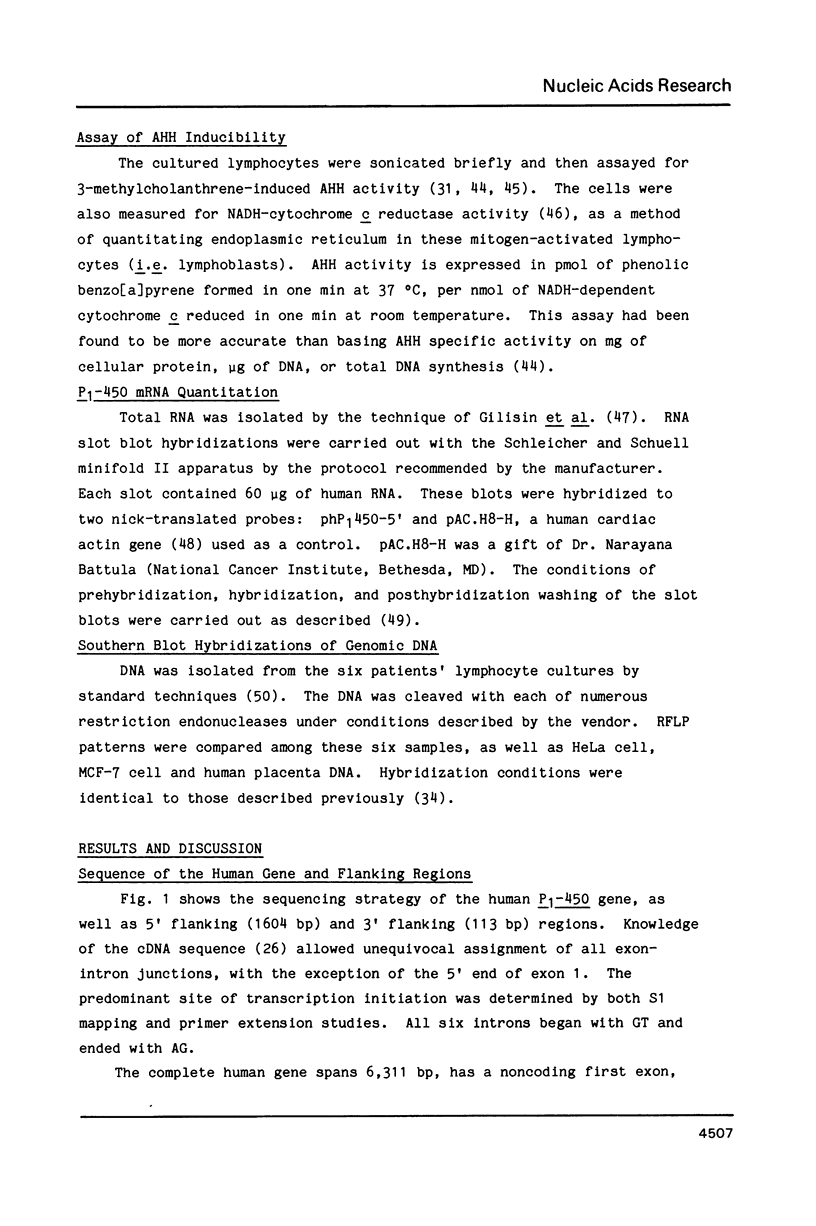
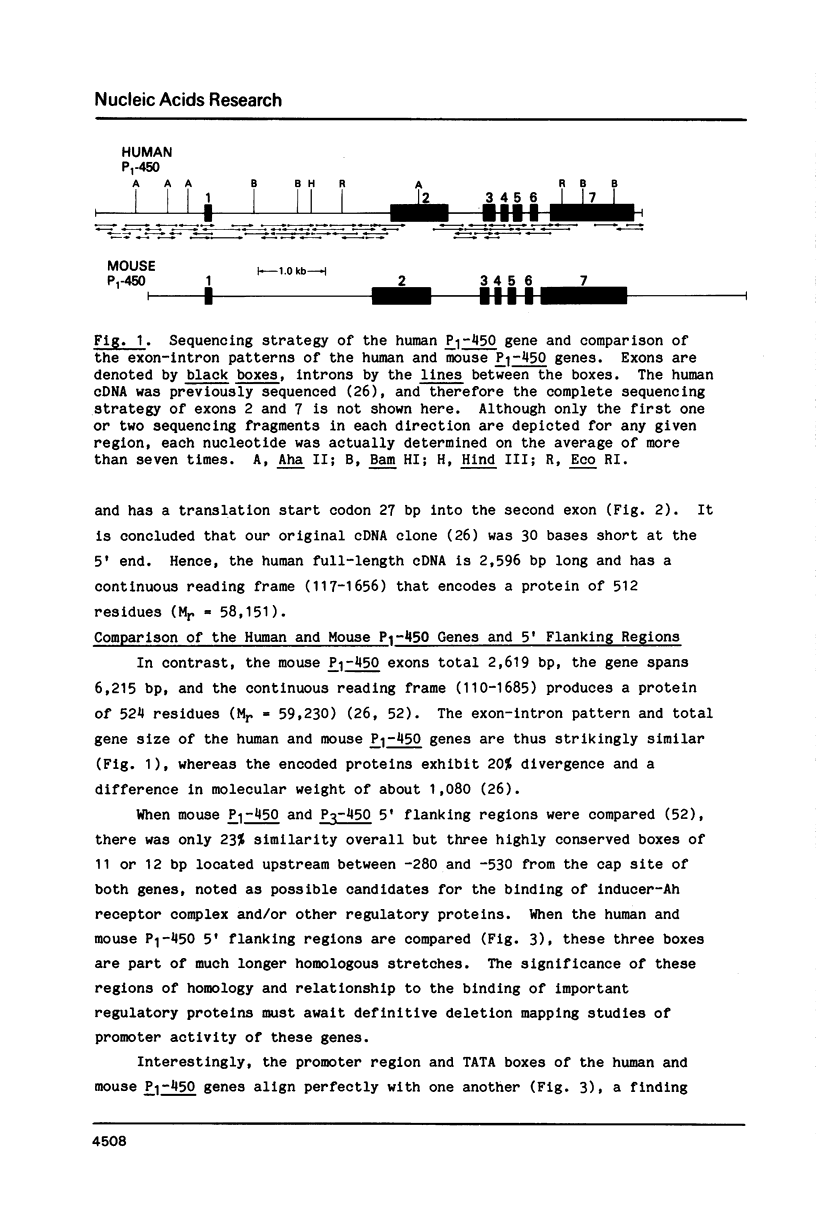
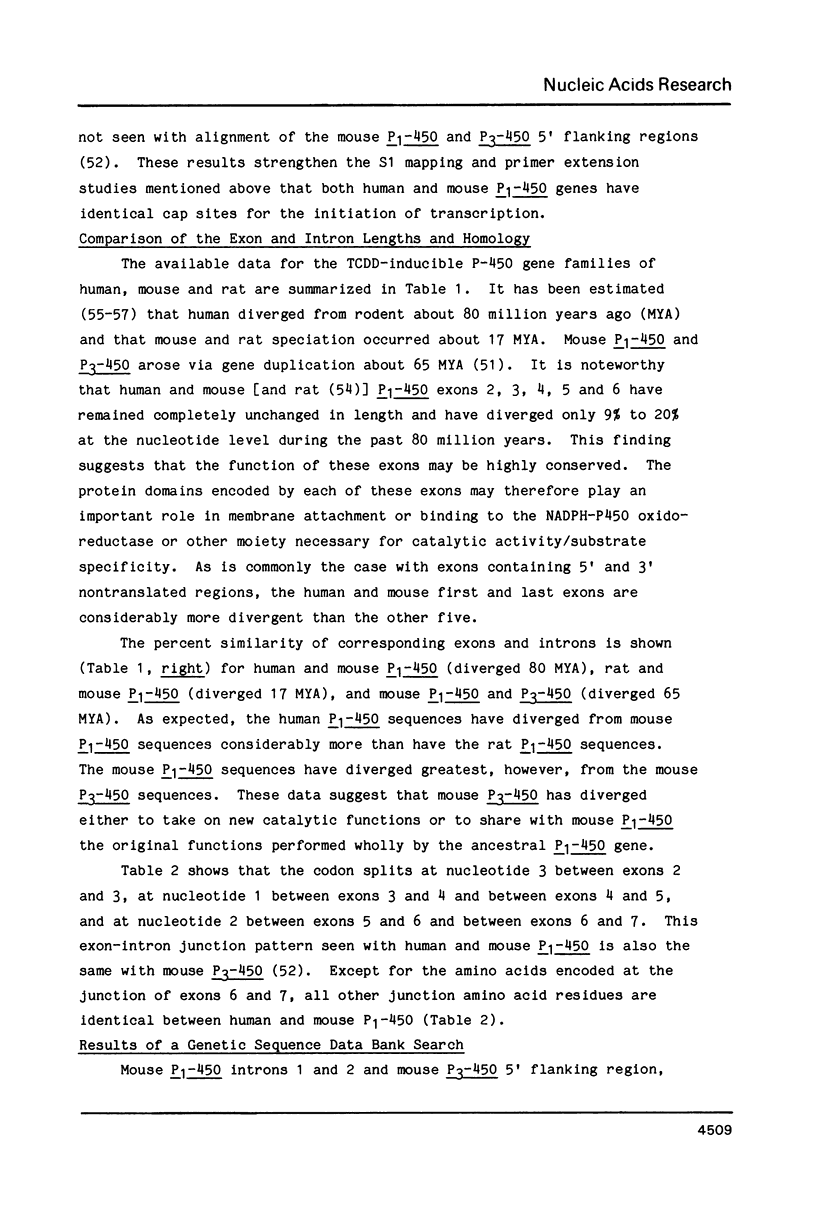
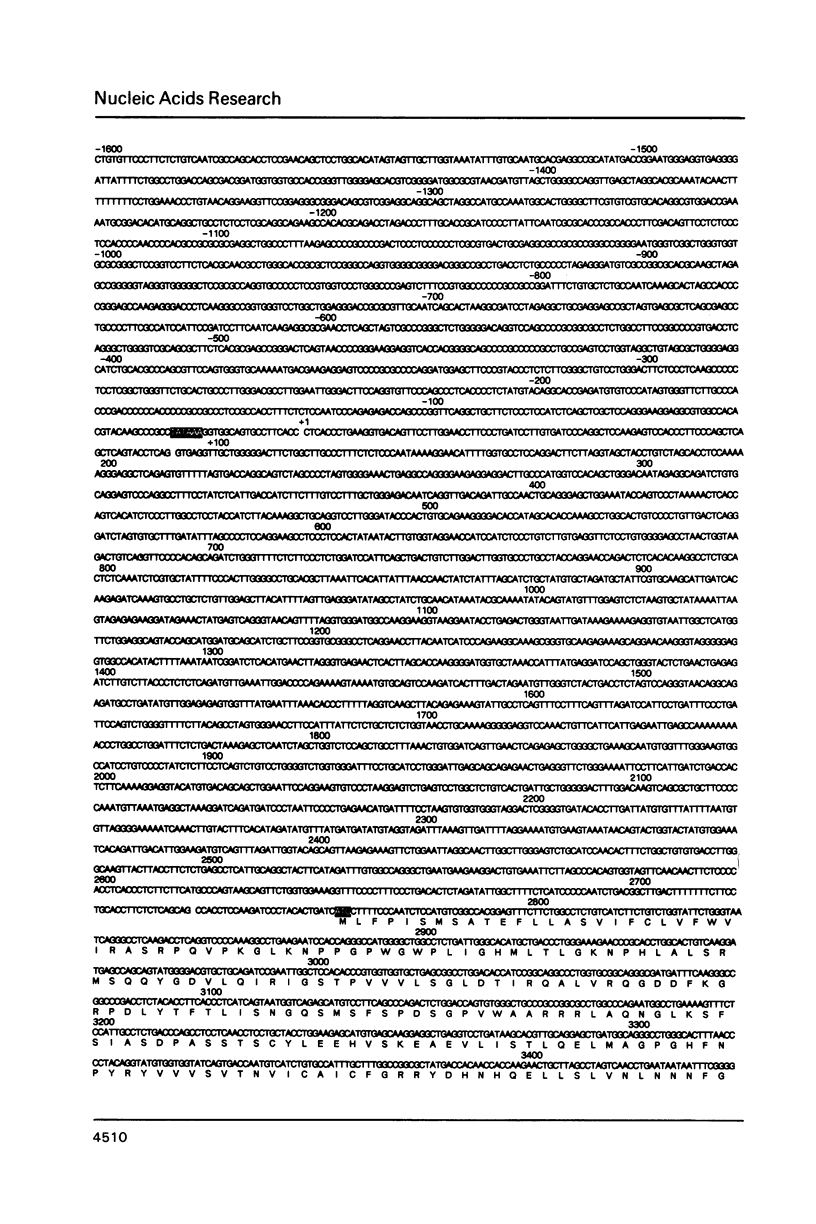
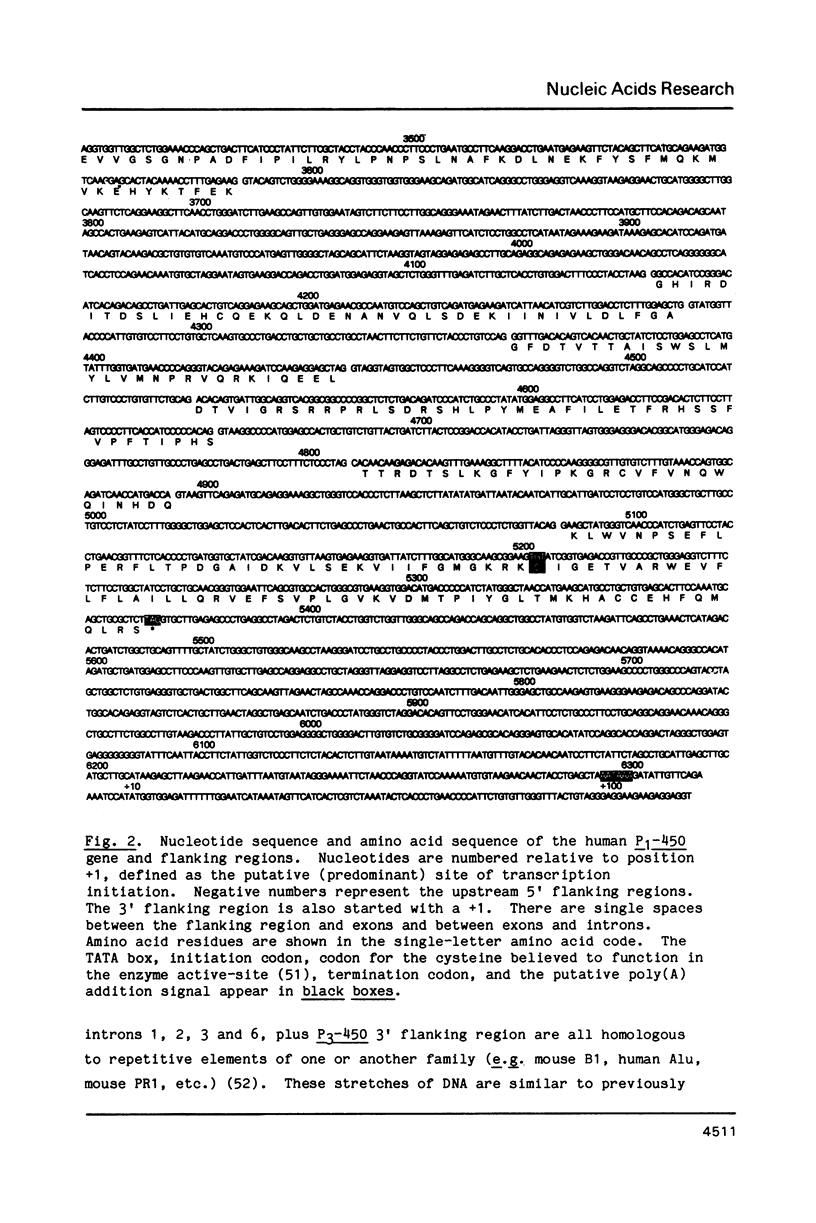
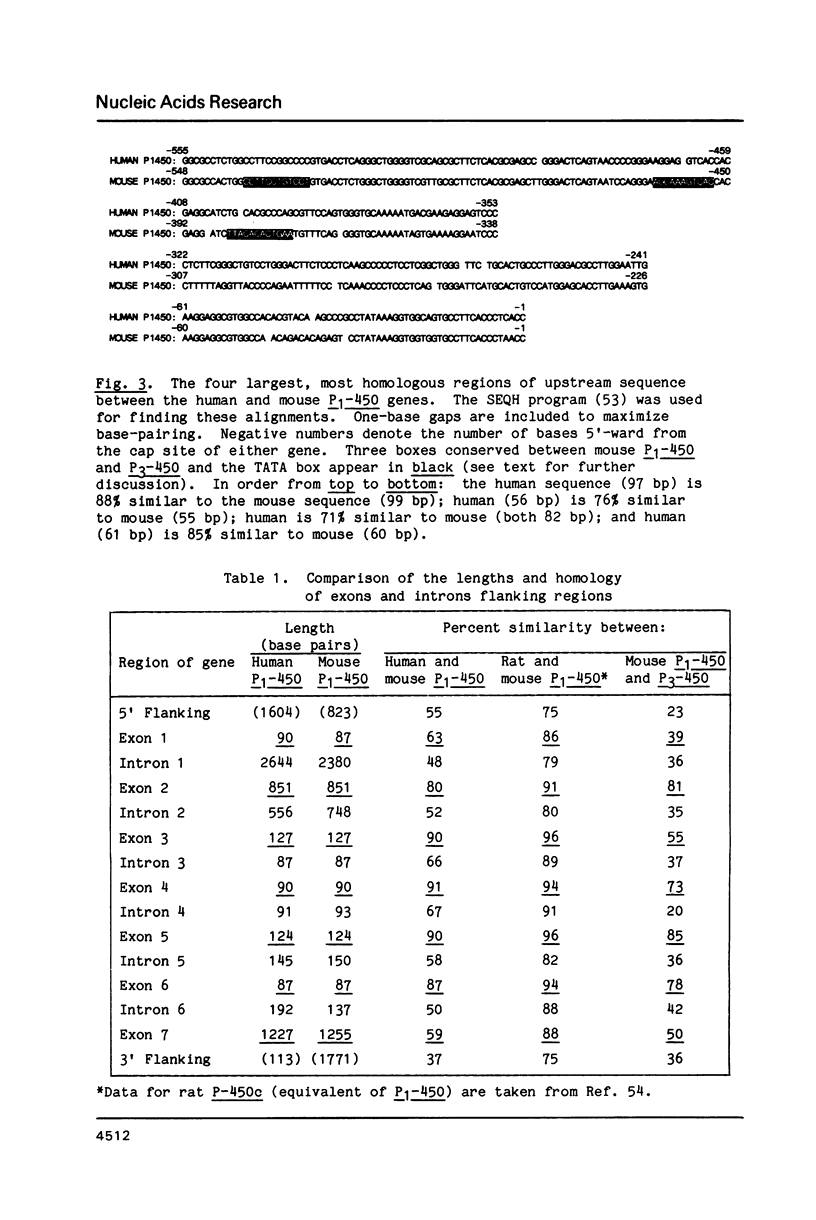
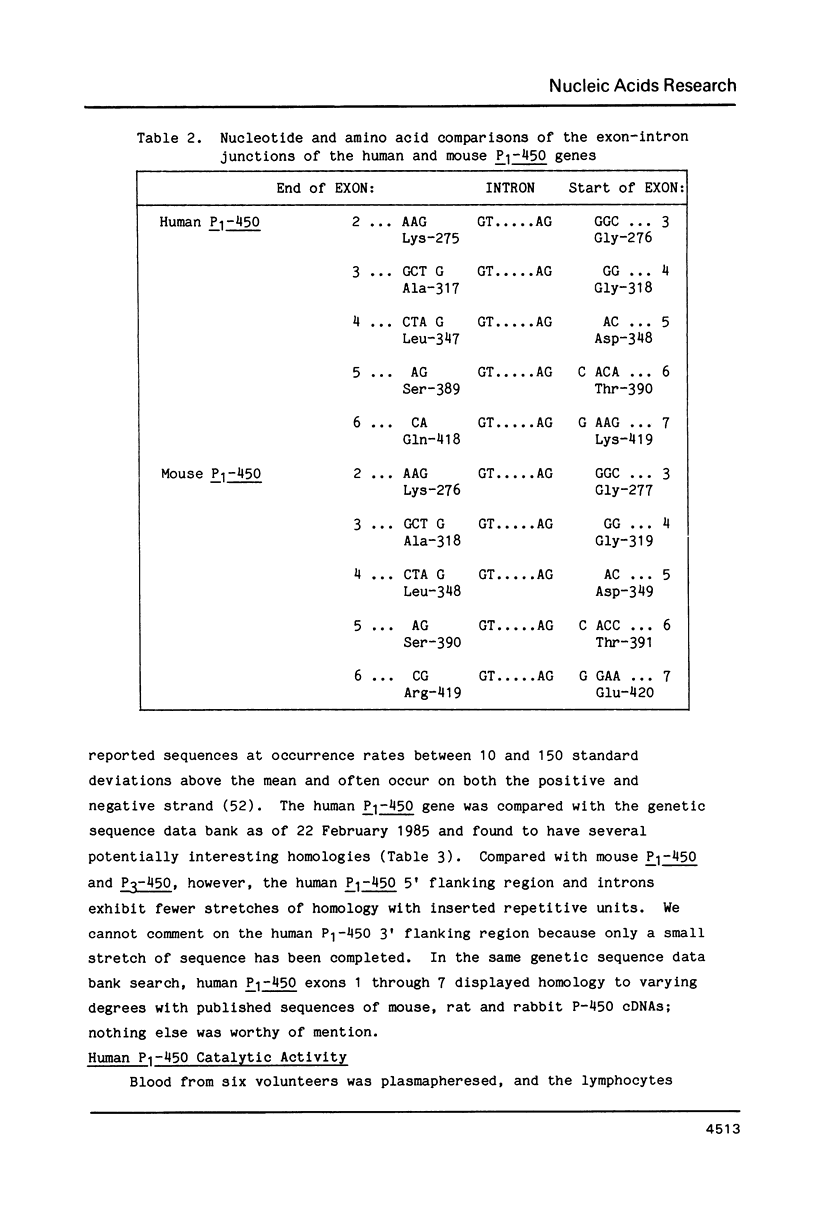
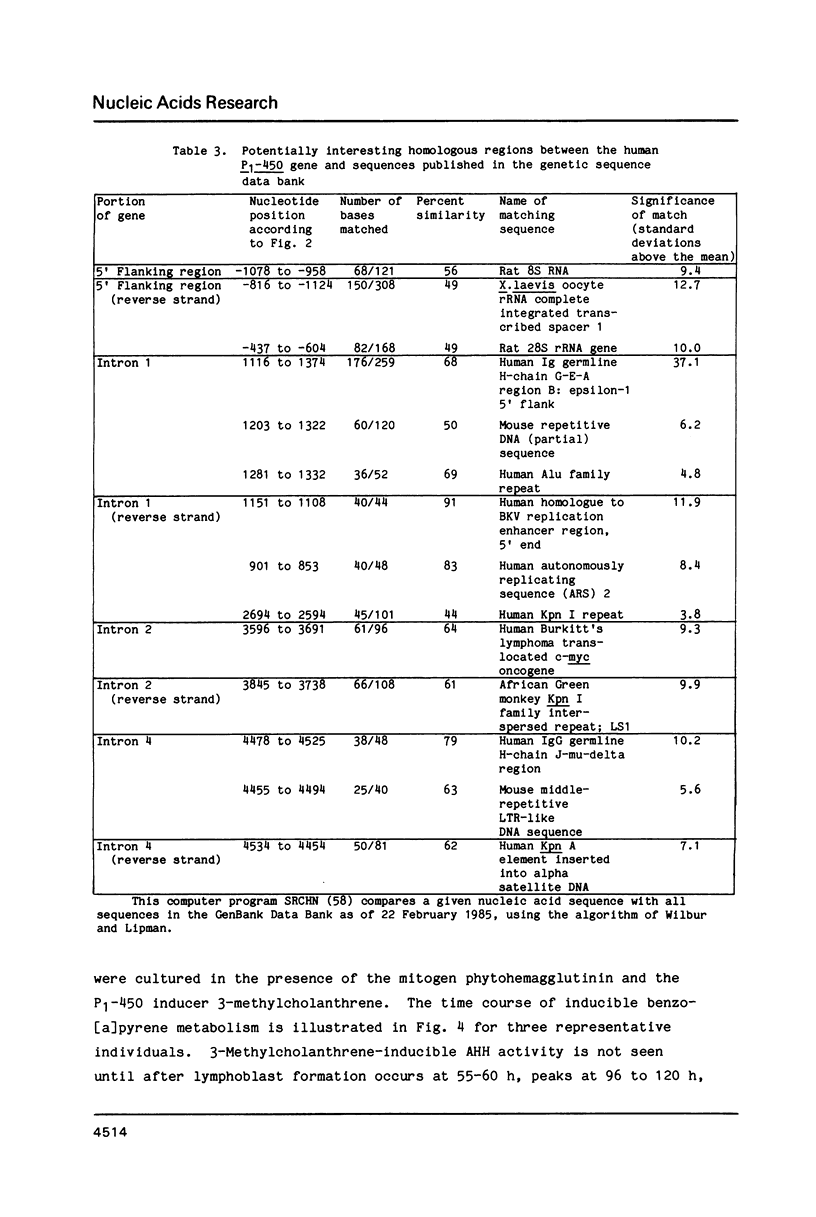
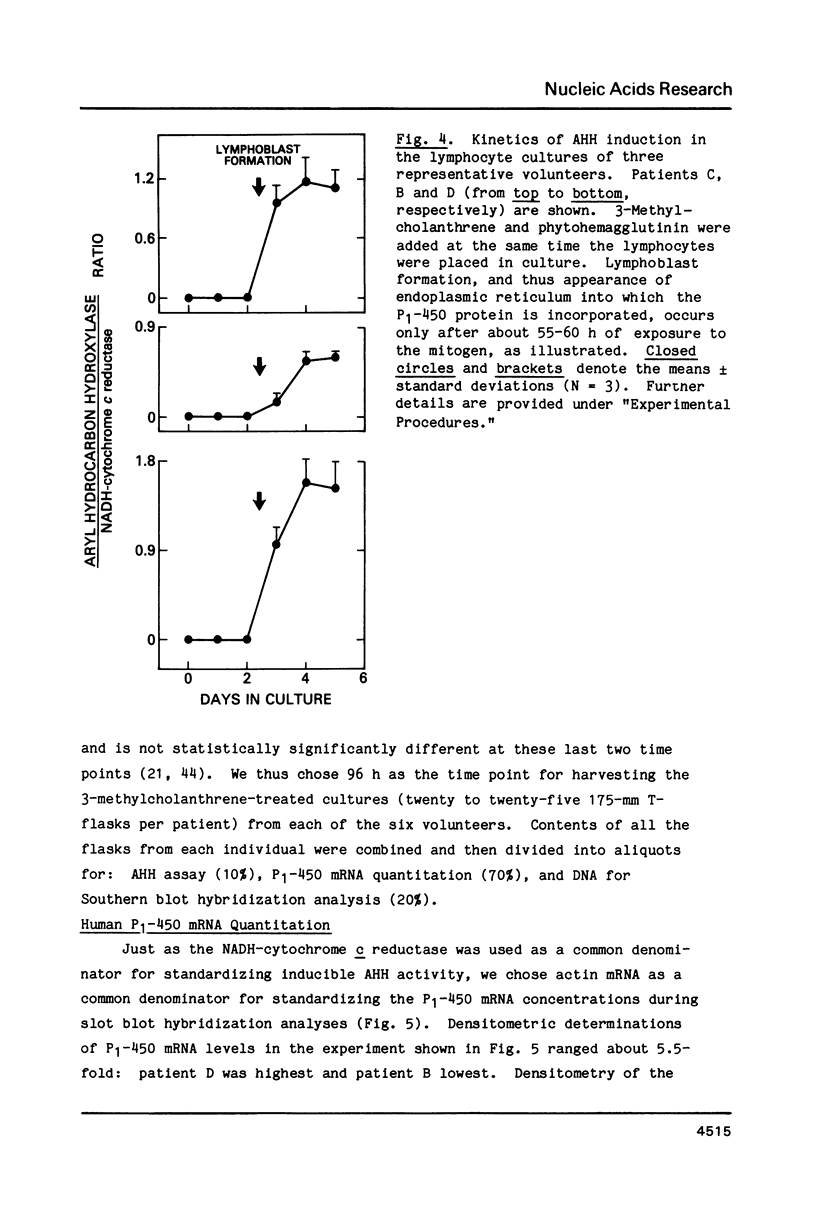
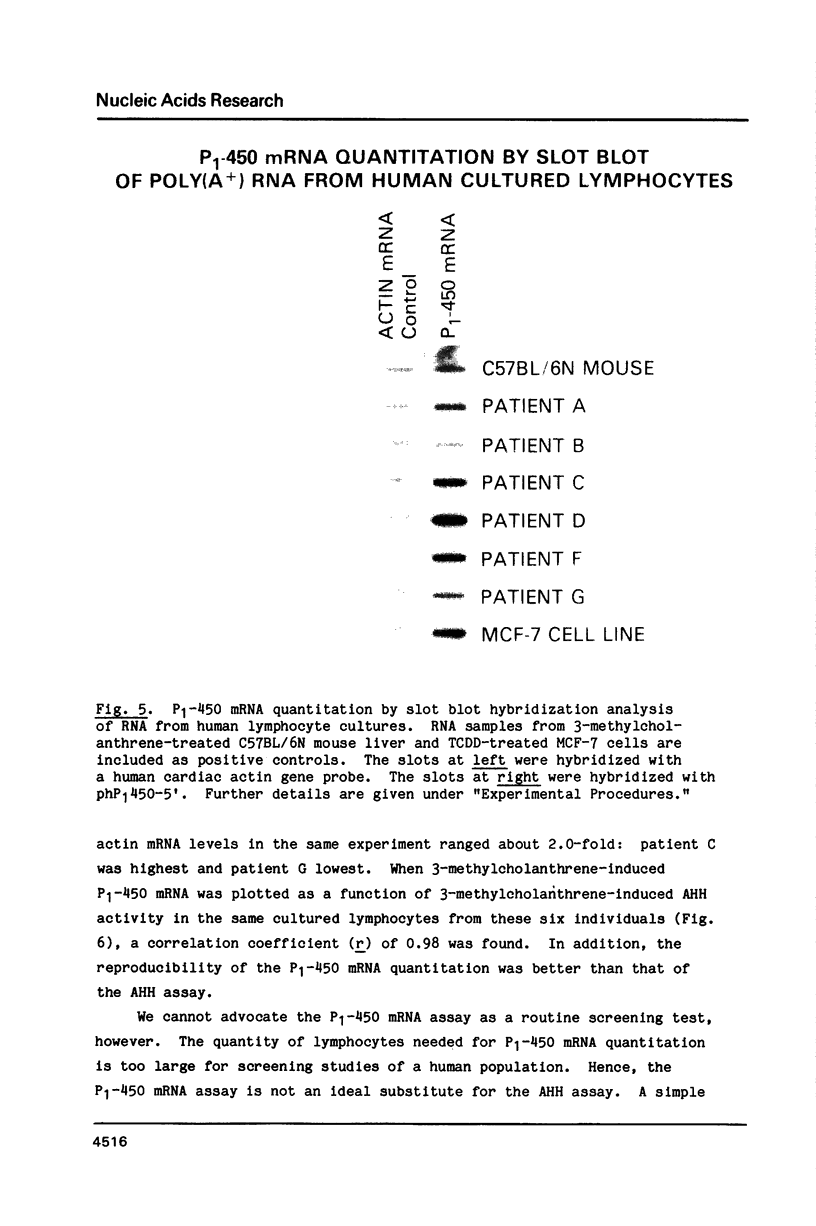
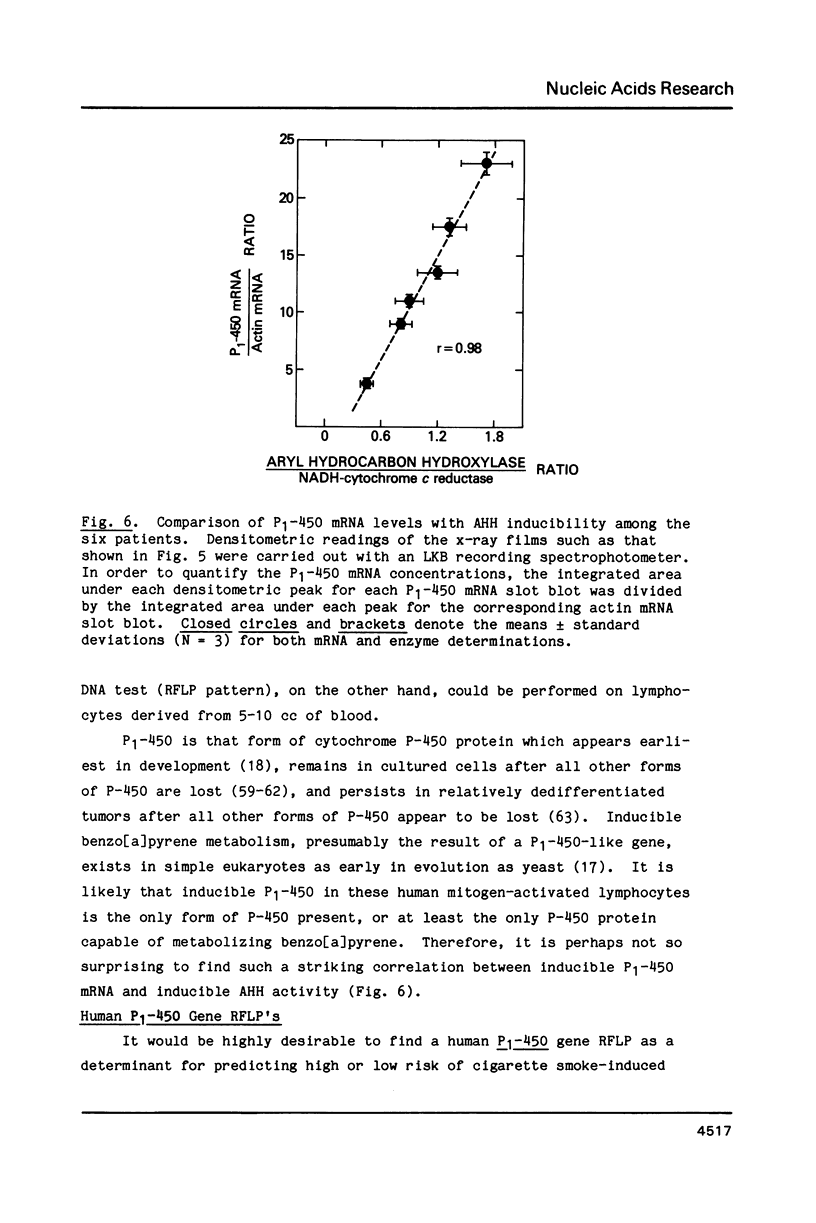
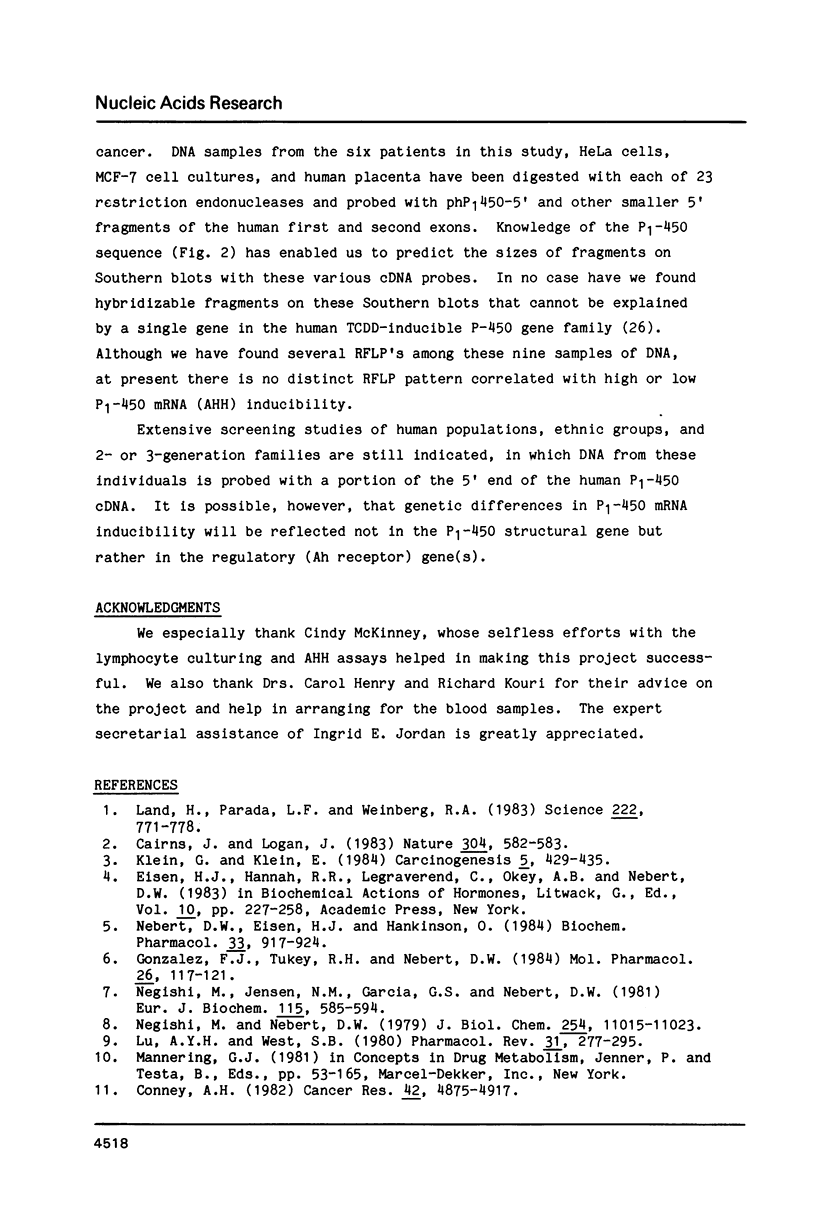
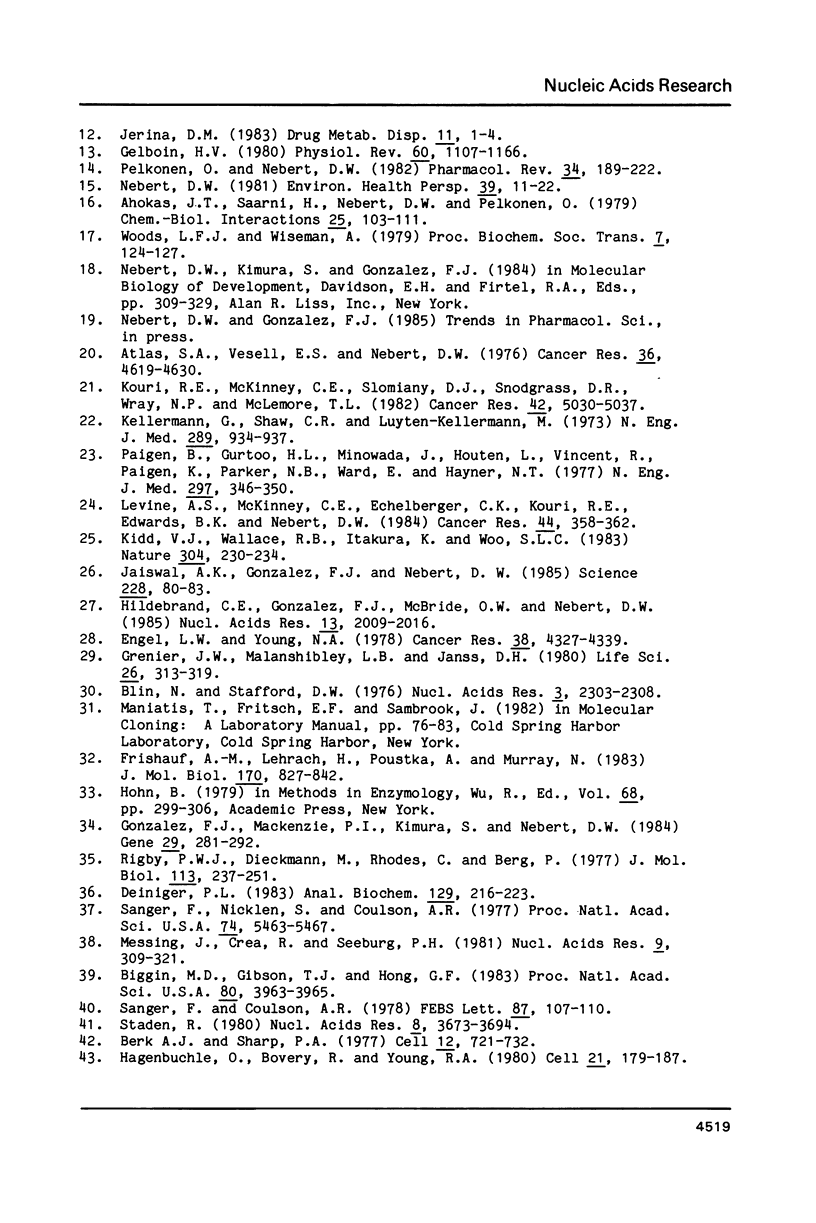
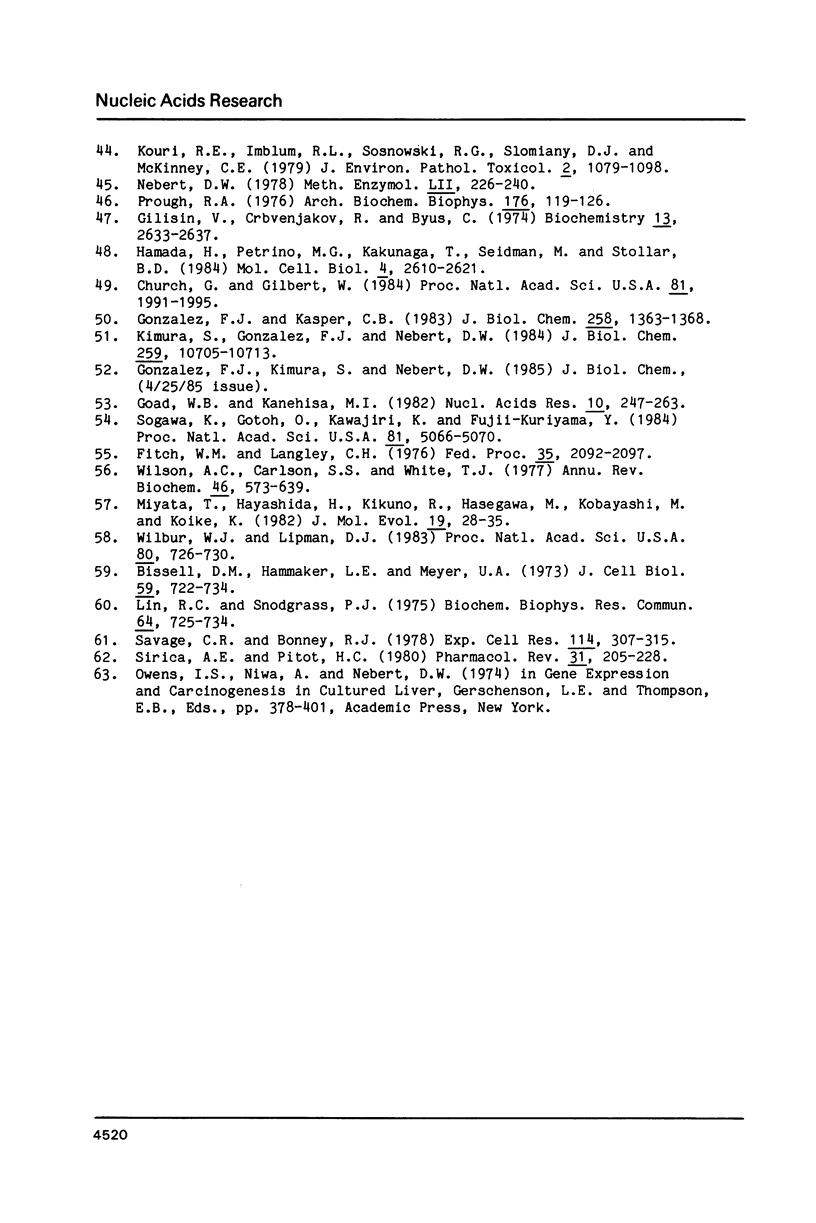
Images in this article
Selected References
These references are in PubMed. This may not be the complete list of references from this article.
- Ahokas J. T., Saarni H., Nebert D. W., Pelkonen O. The in vitro metabolism and convalent binding of benzo[a]pyrene to DNA catalysed by trout liver microsomes. Chem Biol Interact. 1979 Apr;25(1):103–111. doi: 10.1016/0009-2797(79)90072-3. [DOI] [PubMed] [Google Scholar]
- Berk A. J., Sharp P. A. Sizing and mapping of early adenovirus mRNAs by gel electrophoresis of S1 endonuclease-digested hybrids. Cell. 1977 Nov;12(3):721–732. doi: 10.1016/0092-8674(77)90272-0. [DOI] [PubMed] [Google Scholar]
- Biggin M. D., Gibson T. J., Hong G. F. Buffer gradient gels and 35S label as an aid to rapid DNA sequence determination. Proc Natl Acad Sci U S A. 1983 Jul;80(13):3963–3965. doi: 10.1073/pnas.80.13.3963. [DOI] [PMC free article] [PubMed] [Google Scholar]
- Bissell D. M., Hammaker L. E., Meyer U. A. Parenchymal cells from adult rat liver in nonproliferating monolayer culture. I. Functional studies. J Cell Biol. 1973 Dec;59(3):722–734. doi: 10.1083/jcb.59.3.722. [DOI] [PMC free article] [PubMed] [Google Scholar]
- Blin N., Stafford D. W. A general method for isolation of high molecular weight DNA from eukaryotes. Nucleic Acids Res. 1976 Sep;3(9):2303–2308. doi: 10.1093/nar/3.9.2303. [DOI] [PMC free article] [PubMed] [Google Scholar]
- Cairns J., Logan J. Step by step into carcinogenesis. Nature. 1983 Aug 18;304(5927):582–583. doi: 10.1038/304582a0. [DOI] [PubMed] [Google Scholar]
- Conney A. H. Induction of microsomal enzymes by foreign chemicals and carcinogenesis by polycyclic aromatic hydrocarbons: G. H. A. Clowes Memorial Lecture. Cancer Res. 1982 Dec;42(12):4875–4917. [PubMed] [Google Scholar]
- Deininger P. L. Random subcloning of sonicated DNA: application to shotgun DNA sequence analysis. Anal Biochem. 1983 Feb 15;129(1):216–223. doi: 10.1016/0003-2697(83)90072-6. [DOI] [PubMed] [Google Scholar]
- Engel L. W., Young N. A. Human breast carcinoma cells in continuous culture: a review. Cancer Res. 1978 Nov;38(11 Pt 2):4327–4339. [PubMed] [Google Scholar]
- Fitch W. M., Langley C. H. Protein evolution and the molecular clock. Fed Proc. 1976 Aug;35(10):2092–2097. [PubMed] [Google Scholar]
- Frischauf A. M., Lehrach H., Poustka A., Murray N. Lambda replacement vectors carrying polylinker sequences. J Mol Biol. 1983 Nov 15;170(4):827–842. doi: 10.1016/s0022-2836(83)80190-9. [DOI] [PubMed] [Google Scholar]
- Gelboin H. V. Benzo[alpha]pyrene metabolism, activation and carcinogenesis: role and regulation of mixed-function oxidases and related enzymes. Physiol Rev. 1980 Oct;60(4):1107–1166. doi: 10.1152/physrev.1980.60.4.1107. [DOI] [PubMed] [Google Scholar]
- Glisin V., Crkvenjakov R., Byus C. Ribonucleic acid isolated by cesium chloride centrifugation. Biochemistry. 1974 Jun 4;13(12):2633–2637. doi: 10.1021/bi00709a025. [DOI] [PubMed] [Google Scholar]
- Goad W. B., Kanehisa M. I. Pattern recognition in nucleic acid sequences. I. A general method for finding local homologies and symmetries. Nucleic Acids Res. 1982 Jan 11;10(1):247–263. doi: 10.1093/nar/10.1.247. [DOI] [PMC free article] [PubMed] [Google Scholar]
- Gonzalez F. J., Kasper C. B. Cloning and characterization of the rat NADPH-cytochrome P-450 oxidoreductase gene. J Biol Chem. 1983 Jan 25;258(2):1363–1368. [PubMed] [Google Scholar]
- Gonzalez F. J., Mackenzie P. I., Kimura S., Nebert D. W. Isolation and characterization of full-length mouse cDNA and genomic clones of 3-methylcholanthrene-inducible cytochrome P1-450 and P3-450. Gene. 1984 Sep;29(3):281–292. doi: 10.1016/0378-1119(84)90057-x. [DOI] [PubMed] [Google Scholar]
- Gonzalez F. J., Tukey R. H., Nebert D. W. Structural gene products of the Ah locus. Transcriptional regulation of cytochrome P1-450 and P3-450 mRNA levels by 3-methylcholanthrene. Mol Pharmacol. 1984 Jul;26(1):117–121. [PubMed] [Google Scholar]
- Greiner J. W., Malan-Shibley L. B., Janss D. H. Detection of aryl hydrocarbon hydroxylase activity in normal and neoplastic human breast epithelium. Life Sci. 1980 Jan 28;26(4):313–319. doi: 10.1016/0024-3205(80)90343-4. [DOI] [PubMed] [Google Scholar]
- Hagenbüchle O., Bovey R., Young R. A. Tissue-specific expression of mouse-alpha-amylase genes: nucleotide sequence of isoenzyme mRNAs from pancreas and salivary gland. Cell. 1980 Aug;21(1):179–187. doi: 10.1016/0092-8674(80)90125-7. [DOI] [PubMed] [Google Scholar]
- Hamada H., Petrino M. G., Kakunaga T., Seidman M., Stollar B. D. Characterization of genomic poly(dT-dG).poly(dC-dA) sequences: structure, organization, and conformation. Mol Cell Biol. 1984 Dec;4(12):2610–2621. doi: 10.1128/mcb.4.12.2610. [DOI] [PMC free article] [PubMed] [Google Scholar]
- Hildebrand C. E., Gonzalez F. J., McBride O. W., Nebert D. W. Assignment of the human 2,3,7,8-tetrachlorodibenzo-p-dioxin-inducible cytochrome P1-450 gene to chromosome 15. Nucleic Acids Res. 1985 Mar 25;13(6):2009–2016. doi: 10.1093/nar/13.6.2009. [DOI] [PMC free article] [PubMed] [Google Scholar]
- Jaiswal A. K., Gonzalez F. J., Nebert D. W. Human dioxin-inducible cytochrome P1-450: complementary DNA and amino acid sequence. Science. 1985 Apr 5;228(4695):80–83. doi: 10.1126/science.3838385. [DOI] [PubMed] [Google Scholar]
- Jerina D. M. The 1982 Bernard B. brodie Award Lecture. Metabolism of Aromatic hydrocarbons by the cytochrome P-450 system and epoxide hydrolase. Drug Metab Dispos. 1983 Jan-Feb;11(1):1–4. [PubMed] [Google Scholar]
- Kellermann G., Shaw C. R., Luyten-Kellerman M. Aryl hydrocarbon hydroxylase inducibility and bronchogenic carcinoma. N Engl J Med. 1973 Nov 1;289(18):934–937. doi: 10.1056/NEJM197311012891802. [DOI] [PubMed] [Google Scholar]
- Kidd V. J., Wallace R. B., Itakura K., Woo S. L. alpha 1-antitrypsin deficiency detection by direct analysis of the mutation in the gene. Nature. 1983 Jul 21;304(5923):230–234. doi: 10.1038/304230a0. [DOI] [PubMed] [Google Scholar]
- Kimura S., Gonzalez F. J., Nebert D. W. The murine Ah locus. Comparison of the complete cytochrome P1-450 and P3-450 cDNA nucleotide and amino acid sequences. J Biol Chem. 1984 Sep 10;259(17):10705–10713. [PubMed] [Google Scholar]
- Klein G., Klein E. Oncogene activation and tumor progression. Carcinogenesis. 1984 Apr;5(4):429–435. doi: 10.1093/carcin/5.4.429. [DOI] [PubMed] [Google Scholar]
- Kouri R. E., Imblum R. L., Sosnowski R. G., Slomiany D. J., McKinney C. E. Parameters influencing quantitation of 3-methylcholanthrene-induced aryl hydrocarbon hydroxylase activity in cultured human lymphocytes. J Environ Pathol Toxicol. 1979 Mar-Apr;2(4):1079–1098. [PubMed] [Google Scholar]
- Kouri R. E., McKinney C. E., Slomiany D. J., Snodgrass D. R., Wray N. P., McLemore T. L. Positive correlation between high aryl hydrocarbon hydroxylase activity and primary lung cancer as analyzed in cryopreserved lymphocytes. Cancer Res. 1982 Dec;42(12):5030–5037. [PubMed] [Google Scholar]
- Land H., Parada L. F., Weinberg R. A. Cellular oncogenes and multistep carcinogenesis. Science. 1983 Nov 18;222(4625):771–778. doi: 10.1126/science.6356358. [DOI] [PubMed] [Google Scholar]
- Levine A. S., McKinney C. E., Echelberger C. K., Kouri R. E., Edwards B. K., Nebert D. W. Aryl hydrocarbon hydroxylase inducibility among primary relatives of children with leukemia or solid tumors. Cancer Res. 1984 Jan;44(1):358–362. [PubMed] [Google Scholar]
- Lin R. C., Snodgrass P. J. Primary culture of normal adult rat liver cells which maintain stable urea cycle enzymes. Biochem Biophys Res Commun. 1975 May 19;64(2):725–734. doi: 10.1016/0006-291x(75)90380-0. [DOI] [PubMed] [Google Scholar]
- Lu A. Y., West S. B. Multiplicity of mammalian microsomal cytochromes P-45. Pharmacol Rev. 1979 Dec;31(4):277–295. [PubMed] [Google Scholar]
- Messing J., Crea R., Seeburg P. H. A system for shotgun DNA sequencing. Nucleic Acids Res. 1981 Jan 24;9(2):309–321. doi: 10.1093/nar/9.2.309. [DOI] [PMC free article] [PubMed] [Google Scholar]
- Miyata T., Hayashida H., Kikuno R., Hasegawa M., Kobayashi M., Koike K. Molecular clock of silent substitution: at least six-fold preponderance of silent changes in mitochondrial genes over those in nuclear genes. J Mol Evol. 1982;19(1):28–35. doi: 10.1007/BF02100221. [DOI] [PubMed] [Google Scholar]
- Nebert D. W., Eisen H. J., Hankinson O. The Ah receptor: binding specificity only for foreign chemicals? Biochem Pharmacol. 1984 Mar 15;33(6):917–924. doi: 10.1016/0006-2952(84)90446-5. [DOI] [PubMed] [Google Scholar]
- Nebert D. W. Genetic differences in microsomal electron transport: the Ah locus. Methods Enzymol. 1978;52:226–240. doi: 10.1016/s0076-6879(78)52026-0. [DOI] [PubMed] [Google Scholar]
- Nebert D. W. Genetic differences in susceptibility to chemically induced myelotoxicity and leukemia. Environ Health Perspect. 1981 Jun;39:11–22. doi: 10.1289/ehp.813911. [DOI] [PMC free article] [PubMed] [Google Scholar]
- Negishi M., Jensen N. M., Garcia G. S., Nebert D. W. Structural gene products of the murine Ah complex. Differences in ontogenesis and glucosamine incorporation between liver microsomal cytochromes P1-450 and P-448 induced by polycyclic aromatic compounds. Eur J Biochem. 1981 Apr;115(3):585–594. [PubMed] [Google Scholar]
- Negishi M., Nebert D. W. Structural gene products of the Ah locus. Genetic and immunochemical evidence for two forms of mouse liver cytochrome P-450 induced by 3-methylcholanthrene. J Biol Chem. 1979 Nov 10;254(21):11015–11023. [PubMed] [Google Scholar]
- Paigen B., Gurtoo H. L., Minowada J., Houten L., Vincent R., Paigen K., Parker N. B., Ward E., Hayner N. T. Questionable relation of aryl hydrocarbon hydroxylase to lung-cancer risk. N Engl J Med. 1977 Aug 18;297(7):346–350. doi: 10.1056/NEJM197708182970702. [DOI] [PubMed] [Google Scholar]
- Pelkonen O., Nebert D. W. Metabolism of polycyclic aromatic hydrocarbons: etiologic role in carcinogenesis. Pharmacol Rev. 1982 Jun;34(2):189–222. [PubMed] [Google Scholar]
- Prough R. A., Imblum R. L., Kouri R. A. NADH-cytochrome c reductase activity in cultured human lymphocytes. Similarity to the liver microsomal NADH-cytochrome b5 reductase and cytochrome b5 enzyme system. Arch Biochem Biophys. 1976 Sep;176(1):119–126. doi: 10.1016/0003-9861(76)90147-8. [DOI] [PubMed] [Google Scholar]
- Rigby P. W., Dieckmann M., Rhodes C., Berg P. Labeling deoxyribonucleic acid to high specific activity in vitro by nick translation with DNA polymerase I. J Mol Biol. 1977 Jun 15;113(1):237–251. doi: 10.1016/0022-2836(77)90052-3. [DOI] [PubMed] [Google Scholar]
- Sanger F., Coulson A. R. The use of thin acrylamide gels for DNA sequencing. FEBS Lett. 1978 Mar 1;87(1):107–110. doi: 10.1016/0014-5793(78)80145-8. [DOI] [PubMed] [Google Scholar]
- Sanger F., Nicklen S., Coulson A. R. DNA sequencing with chain-terminating inhibitors. Proc Natl Acad Sci U S A. 1977 Dec;74(12):5463–5467. doi: 10.1073/pnas.74.12.5463. [DOI] [PMC free article] [PubMed] [Google Scholar]
- Savage C. R., Jr, Bonney R. J. Extended expression of differentiated function in primary cultures of adult liver parenchymal cells maintained on nitrocellulose filters. I. Induction of phosphoenolpyruvate carboxykinase and tyrosine aminotransferase. Exp Cell Res. 1978 Jul;114(2):307–315. doi: 10.1016/0014-4827(78)90488-3. [DOI] [PubMed] [Google Scholar]
- Sirica A. E., Pitot H. C. Drug metabolism and effects of carcinogens in cultured hepatic cells. Pharmacol Rev. 1979 Sep;31(3):205–228. [PubMed] [Google Scholar]
- Sogawa K., Gotoh O., Kawajiri K., Fujii-Kuriyama Y. Distinct organization of methylcholanthrene- and phenobarbital-inducible cytochrome P-450 genes in the rat. Proc Natl Acad Sci U S A. 1984 Aug;81(16):5066–5070. doi: 10.1073/pnas.81.16.5066. [DOI] [PMC free article] [PubMed] [Google Scholar]
- Staden R. A new computer method for the storage and manipulation of DNA gel reading data. Nucleic Acids Res. 1980 Aug 25;8(16):3673–3694. doi: 10.1093/nar/8.16.3673. [DOI] [PMC free article] [PubMed] [Google Scholar]
- Wilbur W. J., Lipman D. J. Rapid similarity searches of nucleic acid and protein data banks. Proc Natl Acad Sci U S A. 1983 Feb;80(3):726–730. doi: 10.1073/pnas.80.3.726. [DOI] [PMC free article] [PubMed] [Google Scholar]
- Wilson A. C., Carlson S. S., White T. J. Biochemical evolution. Annu Rev Biochem. 1977;46:573–639. doi: 10.1146/annurev.bi.46.070177.003041. [DOI] [PubMed] [Google Scholar]
- Woods L. F., Wiseman A. Metabolism of benzo[a]pyrene by the cytochrome P-450/P-488 of Saccharomyces cerevisiae [proceedings]. Biochem Soc Trans. 1979 Feb;7(1):124–127. doi: 10.1042/bst0070124. [DOI] [PubMed] [Google Scholar]



